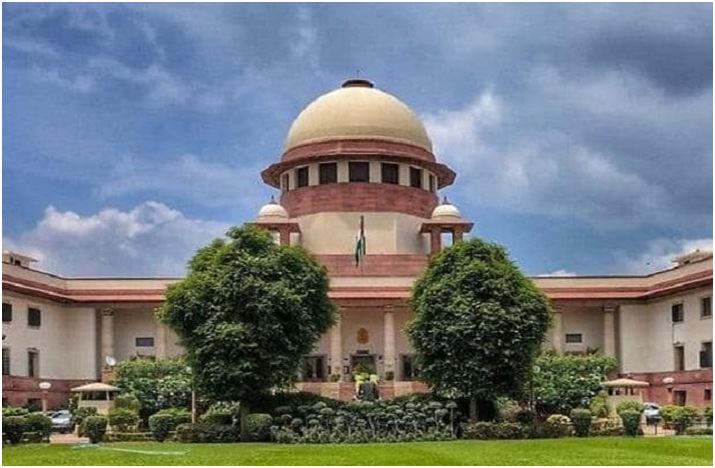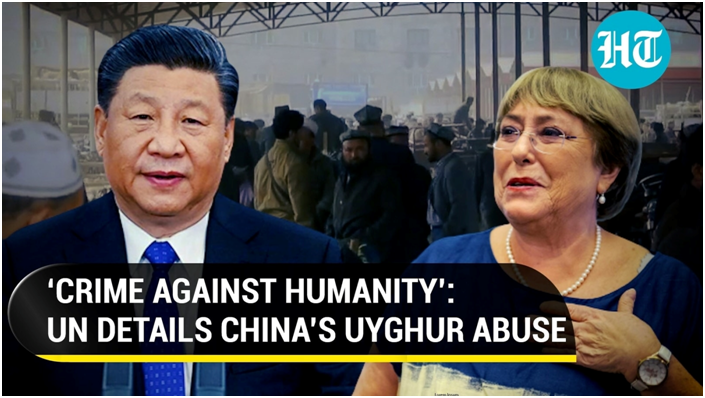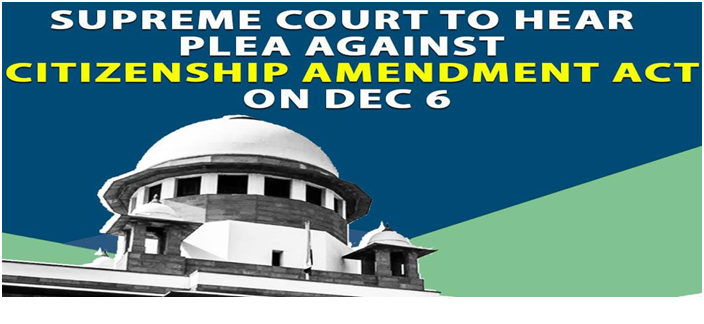Supreme Court deprecates regressive two-finger test on rape victims (GS Paper 2, Judiciary)

Why in news?
- Recently, the Supreme Court (SC) deprecated the ‘regressive’ and ‘invasive’ practice of the 'two-finger test' on rape survivors.
- The SC said that it has no scientific basis and instead re-victimises women who may have been sexually assaulted, and is an affront to their dignity.
What is the two-finger test?
- The test is conducted to check whether the victim has had recent sexual intercourse.
- The test includes an inspection of the hymen. The hymen is inspected as it can be torn only if the woman has had any sexual intercourse. This test was performed on rape or sexual assault survivors.
How is the test conducted?
- The two-finger test is performed by a doctor, who inserts two fingers into the vaginal canal of the rape survivor to check the laxity of her muscles and determine if she has been sexually active.
Is the two-finger test scientifically accepted?
- The answer is no. According to medical experts, science has proved that the hymen is not a reliable source of proving vaginal penetration.
- The hymen, which is a thin membrane in the vagina, can rupture not just during sexual activity but also during day-to-day work or any physical activity, including playing sports.
- Moreover, in cases of sexual assault against children, the hymen being so deep-set often stays intact during penetration. So, according to doctors, this test has no scientific backing.
International stand:
- In 2018, the United Nations Human Rights, UN Women, and the World Health Organization (WHO) called for a ban on the two-finger test in order to eliminate violence against women and declared it as medically unnecessary, often times painful, humiliating and a traumatic practice which must end.
Highlights of the judgement:
- The SC said it is "patriarchal" and "sexist" to suggest that a woman cannot be believed when she states that she was raped, merely for the reason that she is sexually active.
- It said any person who conducts the two-finger test or per vaginum examination (while examining a person alleged to have been subjected to a sexual assault) in contravention of the directions of this court shall be guilty of misconduct.
What was the case before SC?
- A bench of Justices made the remarks in a judgement on a plea of the Jharkhand government in which it challenged the acquittal of one Shailendra Kumar Rai alias Pandav Rai of rape and murder charges.
- The SC overturned the decision of the High Court and upheld the trial court order holding Rai guilty of rape and murder and awarded him life sentence.
- The bench noted that while examining the victim, the medical board of the Sadar hospital at Deoghar in Jharkhand conducted the two-finger test to determine whether she was habituated to sexual intercourse.
Earlier verdict of SC:
- The bench referred to its 2013 verdict in Lillu versus State of Haryana, where it was held that the test violates the right to privacy, integrity, and dignity of a woman.
- The bench added that whether a woman is "habituated to sexual intercourse" or "habitual to sexual intercourse" is irrelevant for the purposes of determining whether the ingredients of Section 375 of the IPC (rape) are present in a particular case.
- The so-called test is based on the incorrect assumption that a sexually active woman cannot be raped.
Section 53A of the Evidence Act:
- The legislature explicitly recognised this fact when it enacted the Criminal Law (Amendment) Act 2013 which inter alia amended the Evidence Act to insert Section 53A.
- In terms of Section 53A of the Evidence Act, evidence of a victim’s character or of her previous sexual experience with any person shall not be relevant to the issue of consent or the quality of consent, in prosecutions of sexual offences.
Government guidelines in 2014:
- The Ministry of Health and Family Welfare had issued guidelines on March 19, 2014, for health providers in cases of sexual violence, Medico-legal care for survivors/victims of sexual violence which proscribe the application of the two-finger test.
What’s next?
- It issued a slew of directions to the Centre and state governments to ensure that the guidelines formulated by the Ministry of Health and Family Welfare are circulated to all government and private hospitals.
- Conduct workshops for health providers to communicate the appropriate procedure to be adopted while examining survivors of sexual assault and rape; and review the curriculum in medical schools with a view to ensuring that the two-finger test or per vaginum examination is not prescribed as one of the procedures to be adopted while examining survivors of sexual assault and rape.
50 countries urge China to release detained Uyghurs
(GS Paper 2, International Relation)
Why in news?
- Condemning China for “severe and systematic” human rights violations in the Xinjiang region, 50 countries signed a statement during a UN debate calling for ''urgent attention'' the atrocities against the Uyghurs.
Demand of signatory countries:
- The 50 signatories include the United States, UK, Germany, France, Japan, Australia, Turkey, Israel, Guatemala and Somalia.
- The signatory countries have urged Beijing to “implement the recommendations of the OHCHR assessment” which include “taking prompt steps to release all individuals arbitrarily deprived of their liberty in Xinjiang, and to urgently clarify the fate and whereabouts of missing family members and facilitate safe contact and reunion.”

Background:
- The condemnation is largely being viewed as a symbolic victory after an earlier attempt to debate on the issue at the UN Human Rights Council (UNHRC) was shot down by a majority of the body’s 47 members after China’s insistence.
- The need to discuss Uyghurs rights violation came in response to a August report by the UNHRC which claimed that China was committing human rights violations in Xinjiang under the garb of its anti-terrorism and anti-extremism policies.
Who are the Uyghurs?
- The Uighurs are a predominantly Muslim minority Turkic ethnic group, whose origins can be traced to Central and East Asia.
- The Uighurs speak their own language, similar to Turkish, and see themselves as culturally and ethnically close to Central Asian nations.
- The Uighurs are considered to be one of the 55 officially recognized ethnic minority communities in China.
- However, China recognises the community only as a regional minority and rejects that they are an indigenous group.
- Currently, the largest population of the Uighur ethnic community lives in Xinjiang region of China.
What atrocities are committed against the Uyghurs?
- Human rights groups have accused China of sweeping a million or more people from the minority groups into detention camps where many have said they were tortured, sexually assaulted, and forced to abandon their language and religion.
- The camps were a ruthless campaign against extremism in Xinjiang that also included draconian birth control policies and all-encompassing restrictions on people’s movement.
- More than one million Uyghurs have been detained and thousands have been sent to prison over the last few years. Many Uyghur Muslims have been lodged in what the state calls “re-education camps”.
- Uyghurs inside and outside the camps are exploited for cheap labour and forced to manufacture clothing and other products for sale both at home and abroad.
How suspension bridges work?
(GS Paper 3, Infrastructure)
Why in news?
- Recently, the bridge that collapsed in Gujarat’s Morbiwas a suspension bridge, a type in which the deck is hung below suspension cables on vertical suspenders.

Structure of a suspension budget:
- The basic structural components of a suspension bridge system include stiffening girders, two or more main suspension cables, and towers and anchorages for cables at either end of the bridge.
- The main cables are suspended between the towers and are connected to the anchorage or the bridge itself. The vertical suspenders carry the weight of the deck and the commuter load on it.
- The design ensures that the load on the suspension cables is transferred to the towers at the two ends, which transfer them further by vertical compression to the ground by way of the anchorage cables.
- All of this balancing has to happen within the permissible weight restrictions for the bridge, given that the deck is hanging in air, supported by the two sets of cables.
- Given that the most important load bearing members are the main suspension cables, the entire cross-section of the main cable is the mainstay of carrying the load and ensuring that buckling does not happen.
- But this is subject to two preconditions: there must be no overloading, and no excessive swaying.
What could have happened?
- Even as an investigation into the accident is pending, the visuals and purported footage prior to the incident seem to suggest that both these preconditions were possibility tested.
- While the weight limit is not known, purported video footage from before the incident seems to suggest the bridge was swaying, possibly because of the large crowd on it.
Role of vertical support:
- The job of the vertical cables in a suspension bridge is to transfer the weight of the deck, by tension, to the twin suspension cables that run horizontally between the two anchorages on either end, which, in turn, transfer the tension to the towers and, through them, to the ground by way of cables whose ends are anchored.
- In Morbi, the vertical cables seem to have snapped entirely from the deck at one end of the bridge, sending part of the unsuspended deck and those on it plunging into the river.
- During the recent repairs, the original wooden deck had possibly been replaced with an aluminum deck, which could have involved rewiring the mechanism connecting the vertical cables with the deck, thereby likely altering the basic structure of the bridge that had endured for well over a century.
Why suspension bridges?
- Besides suspension, bridges can be arch bridges, beam bridges, cantilever bridges, truss bridges and tied-arch bridges.
- While beam bridges are among the simplest and oldest bridges, the reason for the enduring design of the suspension bridge is that the supporting cables running horizontally between the two far-flung anchorages provide the counterweight and effectively pass on the entire tensional force to the anchorages.
- As a result, suspension bridges can easily cross distances of well over 2,000 metres, beyond the scope of other bridge designs.
- The Morbibridge was on the smaller side in terms of span, and was pedestrian-only.
Suspension bridges elsewhere:
- The core design of a bridge determines how it distributes the internal forces of tension, compression, torsion, bending, and sheer. Suspension bridges are among the most robust structures, starting from the earliest ones made of twisted grass.
- When Spanish conquistadors made their way into Peru in 1532, they discovered an Incan empire connected by hundreds of suspension bridges spanning deep mountain gorges.
- The Golden Gate Bridge and Brooklyn Bridge in the US are examples of suspension bridges.
- India’s longest single-lane motorable suspension bridge, the 725-metre Dobra-Chanti suspension bridge built over the Tehrilakewas inaugurated in November 2020.
A pathway to citizenship for Indian-origin Tamils
(GS Paper 2, Polity and Governance)
Context:
- The Supreme Court of India has now posted the 232 petitions challenging the Citizenship (Amendment) Act (CAA) to be heard on December 6, 2022.
- However, there is another issue linked to the subject, i.e., the unresolved status of Indian-origin Tamils who repatriated from Sri Lanka.

Why it matters?
- For over four decades, nearly 30,000 Indian-origin Tamils have been classified as stateless persons, based on technicalities.
- Given their genealogical link to India, the Government of India needs to consider extending citizenship benefits to them in accordance with Indian bilateral obligations and international humanitarian principles and international conventions.
Historical aspect:
- Under the British colonial government, Indian-origin Tamilswere brought in as indentured labourers to work in plantations. They remained mostly legally undocumented and socially isolated from the native Sri Lankan Tamil and Sinhalese communities due to the policies of the British.
- After 1947, Sri Lanka witnessed rising Sinhalese nationalism, leaving no room for their political and civil participation. They were denied citizenship rights and existed as a ‘stateless’ population, numbering close to 10 lakh by 1960.
- As an ethno-linguistic minority without voting rights, this resulted in a double disadvantage till the two national governments addressed this issue.
Events during 1964-1982:
- Subsequently, under the bilateral Sirimavo-Shastri Pact (1964) and the Sirimavo-Gandhi Pact (1974), six lakh people along with their natural increase would be granted Indian citizenship upon their repatriation. Thus, the process of granting Indian-origin Tamils (who returned to India till around 1982) began.
- However, the Sri Lankan civil war resulted in a spike in Sri Lankan Tamils and Indian-origin Tamils together seeking asylum in India. This resulted in a Union Ministry of Home Affairs directive to stop the grant of citizenship to those who arrived in India after July 1983.
- Furthermore, the focus of the Indian and Tamil Nadu governments shifted to refugee welfare and rehabilitation.
Illegal migrants:
- Over the next 40 years, the legal destiny of Indian-origin Tamils has been largely intertwined with that of Sri Lankan Tamil refugees, and both cohorts have been relegated to ‘refugee’ status.
- This is because Indian-origin Tamils who arrived after 1983 came through unauthorised channels or without proper documentation, and came to be classified as ‘illegal migrants’ as per the CAA 2003. This classification has resulted in their statelessness and blocking of potential legal pathways to citizenship.
Overcoming statelessness:
- While constitutional courts have not had an occasion to deal with the question of statelessness, there have been two recent judgments (Madurai Bench of the Madras High Court, Justice G.R. Swaminathan), taking these issues head on.
- In P. Ulaganathan vs Government of India (2019), the status of citizenship of Indian-origin Tamils at the Kottapattu and Mandapam camps came up for consideration.
- The court recognised the distinction between Indian-origin Tamils and Sri Lankan Tamils and held that a continuous period of statelessness of Indian-origin Tamils offends their fundamental right under Article 21 of the Constitution of India.
- The court further held that the Union Government has implied powers to grant relaxation in conferring citizenship and prescribed that a humanitarian approach, shorn of the rigours of law, should be adopted.
Abirami S. vs The Union of India 2022:
- The court held in Abirami S. vs The Union of India 2022, that statelessness is something to be avoided.
- The court further held that the principles of the CAA, 2019, which relaxes the conditions for citizenship for Hindus from Afghanistan, Pakistan and Bangladesh, would also apply to Sri Lankan Tamil refugees.
- As such, these judgments have provided categorial judicial guidance to the Union of India on how to utilise an expanded and liberal interpretation of the CAA, 2019 to overcome statelessness.
De jure statelessness:
- The situation of statelessness of Indian-origin Tamils is ‘de jure’, created from the failure in implementing the 1964 and 1974 pacts.
- De jure statelessness is recognised in international customary law. Therefore, India has an obligation to remedy the situation.
Chakma refugees:
- In the case of the Chakma refugees, the Supreme Court ( Committee for C.R. of C.A.P. and Ors. vs State of Arunachal Pradesh 2015) held that an undertaking made by the Government of India with respect to grant of citizenship inheres a right in the stateless or refugee population.
- As such, India has made repeated undertakings, through the 1964 and 1974 pacts, which have created a legitimate expectation among the Indian-origin Tamils and would entitle them to be granted citizenship.
Remedy of statelessness in other nations:
- While dealing with a similar situation, in 1994, the United States enacted the Immigration and the Nationality Technical Corrections Act to retroactively grant citizenship to all children born to an alien father and citizen mother.
- Similarly, Brazil, through the Constitutional Amendment No. 54 of 2007 retroactively granted citizenship to children under jus sanguinis, which was earlier stripped by an earlier amendment, i.e., Constitutional Amendment No. 3 of 1994.
- Therefore, any corrective legislative action by the Government of India to eliminate statelessness should necessarily include retroactive citizenship for Indian-origin Tamils.
Way Forward:
- According to a recent report by the United Nations High Commission for Refugees, “Comprehensive Solutions Strategy for Sri Lankan Refugees”, there are around 29,500 Indian-origin Tamils currently living in India.
- As such, when the Union Government makes its case before the Supreme Court to extend citizenship to Indian-origin persons from Pakistan, Afghanistan and Bangladesh seeking asylum in India, it cannot deny Indian-origin Tamils their rightful pathway to citizenship.





